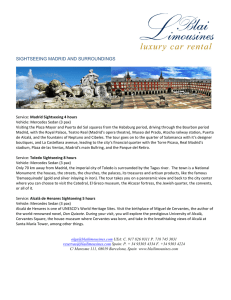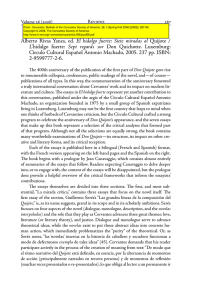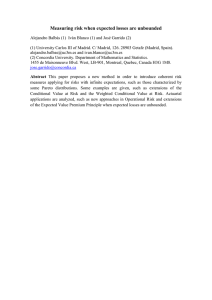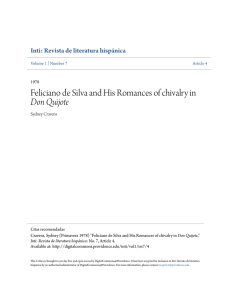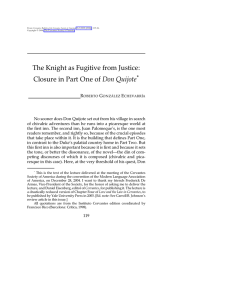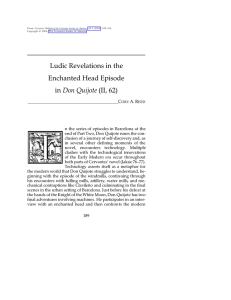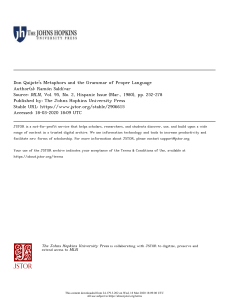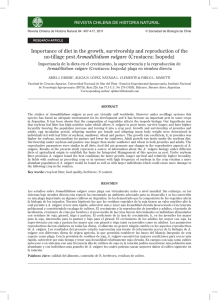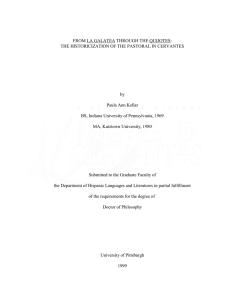The perception of plants in the complete works of Cervantes
Anuncio
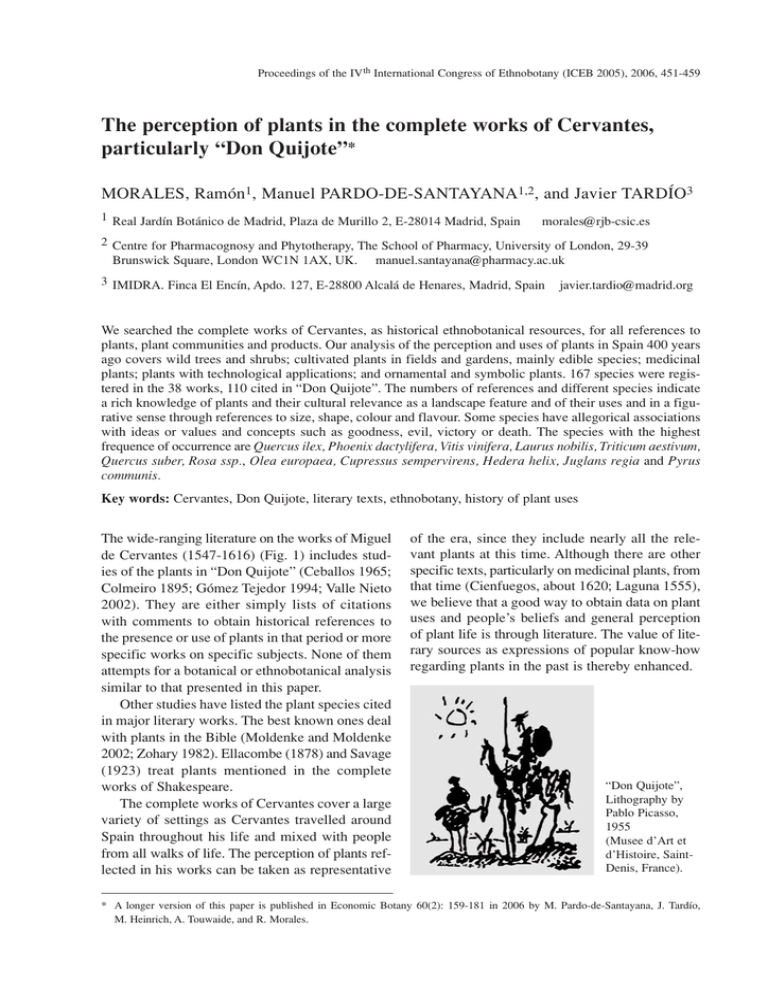
Proceedings of the IV th International Congress of Ethnobotany (ICEB 2005), 2006, 451-459 The perception of plants in the complete works of Cervantes, particularly “Don Quijote”* MORALES, Ramón1, Manuel PARDO-DE-SANTAYANA1,2, and Javier TARDÍO3 1 Real Jardín Botánico de Madrid, Plaza de Murillo 2, E-28014 Madrid, Spain morales@rjb-csic.es 2 Centre for Pharmacognosy and Phytotherapy, The School of Pharmacy, University of London, 29-39 Brunswick Square, London WC1N 1AX, UK. manuel.santayana@pharmacy.ac.uk 3 IMIDRA. Finca El Encín, Apdo. 127, E-28800 Alcalá de Henares, Madrid, Spain javier.tardio@madrid.org We searched the complete works of Cervantes, as historical ethnobotanical resources, for all references to plants, plant communities and products. Our analysis of the perception and uses of plants in Spain 400 years ago covers wild trees and shrubs; cultivated plants in fields and gardens, mainly edible species; medicinal plants; plants with technological applications; and ornamental and symbolic plants. 167 species were registered in the 38 works, 110 cited in “Don Quijote”. The numbers of references and different species indicate a rich knowledge of plants and their cultural relevance as a landscape feature and of their uses and in a figurative sense through references to size, shape, colour and flavour. Some species have allegorical associations with ideas or values and concepts such as goodness, evil, victory or death. The species with the highest frequence of occurrence are Quercus ilex, Phoenix dactylifera, Vitis vinifera, Laurus nobilis, Triticum aestivum, Quercus suber, Rosa ssp., Olea europaea, Cupressus sempervirens, Hedera helix, Juglans regia and Pyrus communis. Key words: Cervantes, Don Quijote, literary texts, ethnobotany, history of plant uses The wide-ranging literature on the works of Miguel de Cervantes (1547-1616) (Fig. 1) includes studies of the plants in “Don Quijote” (Ceballos 1965; Colmeiro 1895; Gómez Tejedor 1994; Valle Nieto 2002). They are either simply lists of citations with comments to obtain historical references to the presence or use of plants in that period or more specific works on specific subjects. None of them attempts for a botanical or ethnobotanical analysis similar to that presented in this paper. Other studies have listed the plant species cited in major literary works. The best known ones deal with plants in the Bible (Moldenke and Moldenke 2002; Zohary 1982). Ellacombe (1878) and Savage (1923) treat plants mentioned in the complete works of Shakespeare. The complete works of Cervantes cover a large variety of settings as Cervantes travelled around Spain throughout his life and mixed with people from all walks of life. The perception of plants reflected in his works can be taken as representative of the era, since they include nearly all the relevant plants at this time. Although there are other specific texts, particularly on medicinal plants, from that time (Cienfuegos, about 1620; Laguna 1555), we believe that a good way to obtain data on plant uses and people’s beliefs and general perception of plant life is through literature. The value of literary sources as expressions of popular know-how regarding plants in the past is thereby enhanced. “Don Quijote”, Lithography by Pablo Picasso, 1955 (Musee d’Art et d’Histoire, SaintDenis, France). * A longer version of this paper is published in Economic Botany 60(2): 159-181 in 2006 by M. Pardo-de-Santayana, J. Tardío, M. Heinrich, A. Touwaide, and R. Morales. 452 Proceedings of ICEB 2005 Materials and methods We reviewed the complete works of Miguel de Cervantes, noting all mentions of plant species, communities and products. We used a 1940 edition published by M. Aguilar, which includes a total of 38 works (Table 1). Using the Spanish names, the botanical species to which the latter correspond were assigned on the basis of the studies of Morales et al. (1996) and Ríos (1991). Table 1. Names of plants mentioned in the works of Cervantes. References: 1. Don Quijote; 2. La Galatea; 3. Los trabajos de Persiles y Sigismunda; 4. Doce Novelas ejemplares; 5. Diez Obras teatrales y doce Entremeses; 6. Viaje al Parnaso. Species Abelmoschus moschatus Medic. Acanthus mollis L. Allium cepa L. Allium porum L. Allium sativum L. Aloe vera L. Amaranthus blitum L. Amaranthus caudatus L. Ammi visnaga (L.) Lam. Anastatica hierochuntica L. Arctium minus Bernh. Arundo donax L. Asparagus officinalis L. Bellis perennis L. Boswellia sacra Flueckiger Brassica napus L. Brassica oleracea L. Briza media L. Buxus sempervirens L. Calamus rotang L. Cannabis sativa L. Capparis spinosa L. Capsicum annuum L. Castanea sativa Miller Cedrus atlantica (Endl.) Carrière Ceratonia siliqua L. Chamaerops humilis L. Cicer arietinum L. Cichorium endivia L. Cichorium intybus L. Cistus ladanifer L. Citrullus colocynthis (L.) Schrader Citrullus lanatus (Thunb.) Matsum. & Nakai Citrus aurantium L. Citrus limon (L). Burm. fil. Cladophora sp. Names cited algalia (muskmallow) acanto (acanthus) cebolla (onion) porro (cultivated leek) ajo (garlic) acíbar (aloe vera) bledos (purple amaranth) amaranto (pigweed) biznaga (toothpick weed) rosa de Hierico (rose of Jerico) lampazo (common burdock) caña (giant reed) espárrago (asparagus) margarita (daisy) incienso (incense) nabo (turnip) berza, col, repollo (cabbage) cedacillo (quaking grass) boj (box) junco de las Indias (rattan palm) cáñamo (hemp) alcaparrones (caper) pimiento (pepper) castaño (chestnut) cedro (cedar) algarroba (carob) palmito (European fan palm) garbanzo (chickpea) escarolado (curly as endives) chicoria (chicory) jaral (cistus) tuera (colocynth) badea (watermelon) naranjo (orange tree), azahar (orange blossom) limón (lemon) ovas (freshwater alga) References 1,4 2 1,5 1 1 1,4,5 1 1,3 5 3 1 1,2,3,4,5 1,5 1,4 2,5 1 1,5 5 2 4 1,3 4 4 1,4 3,6 1,2,5,6 1,5 1 1 1 1,5 1,2 1 1,4,5 4,5 6 Morales, Pardo-de-Santayana, and Tardío: “Don Quijote” Species Cocos nucifera L. Commiphora abyssinica Engl. Corylus avellana L. Crocus sativus L. Cucumis melo L. Cucumis sativus L. Cupressus sempervirens L. Cydonia oblonga Miller Cynodon dactylon (L.) Pers. Cyperus esculentus L. Cyperus longus L. Daucus carota L. Delphinium staphisagria L. Dianthus caryophyllus L. Dianthus plumarius L. Diospyrus ebenum J. G. Kónig Dipsacus sativus (L.) Honck. Erysimum cheiri (L.) Crantz Euphorbia lathyris L. Fagopyrum esculentum Moench Fagus sylvatica L. Ferula communis L. Ficus carica L. Foeniculum vulgare Miller Fraxinus angustifolia Vahl Genista scorpius (L.) DC. Gladiolus communis L. Gossypium herbaceum L. Hedera helix L. Hordeum vulgare L. Hyacinthus orientalis L. Hyoscyamus albus L. Hyssopus officinalis L. Ilex aquifolium L. Iris germanica L. Jasminum officinale L. Juglans regia L. Juncus maritimus Lam. Juniperus oxycedrus L. Juniperus phoenicea L. Lagenaria siceraria (Molina) Standley Laurus nobilis L. Lavandula latifolia Medic. Lavandula pedunculata (Miller) Cav. Lens culinaris Medicus Names cited coco (coconut) mirra (myrrh) avellana (hazelnut) azafrán (saffron) melón (melon) pepino (cucumber) ciprés (cypress) membrillo (quince) grama (bermuda grass) cotufa (earth almond) juncia (galingale) zanahoria (carrot) albarrazado (larkspur) clavel (carnation) clavelina (cottage pink) ébano (ebony) carda (teasel) alhelí (privet) tártago (moleplant) rubión (buckwheat) haya (beech) cañaheja (giant fennel) cabrahigo (wild fig tree), higueral (grove of fig trees), higo (fig) hinojo (fennel) fresno (ash) aliaga (gorse) palmilla (swordlily) algodón (cotton) hiedra (ivy) cebada, alcacel (barley) jacinto (hyacinth) beleño (henbane) hisopo (hyssop) acebo (holly) lirio (iris) jazmin (jasmin) nogal (walnut tree), nuez (walnut) junco marino (sea rush) enebro (juniper), miera (juniper oil) sabina (Phoenician juniper) calabaza (pumpkin) laurel (laurel) alhucema (spike lavender) cantueso (lavender) lantejas (lentils) 453 References 1,3 4 1,3,4,5 5 1,5 1,5 1,2,3,4,6 1,4,5 1 1 2,3,4,5,6 1 1,5 4,5 2,5 1,3,5 1,4,6 1,5 1 1 1,2 1 1,3,4,5 1,4 1,2,5 1 1,3 1,4 1,2,3,5,6 1,4,5 4,5 2,6 1,3,6 1 1,2,5 1,2,4,5,6 1,2,3,4,5 1 2,4 3 1,3,4,5,6 1,2,4,5,6 1 1,4 1 454 Species Ligustrum vulgare L. Lilium candidum L. Linum usitatissimum L. Lolium temulentum L. Lonicera periclymenum L. Lycium barbarum L. Malus domestica Borkh. Malva sylvestris Miller Matricaria recutita (L.) Rauschert Medicago sativa L. Melia acedarach L. Mentha pulegium L. Mentha suaveolens Ehrh. Mespilus germanica L. Myrtus communis L. Narcissus pseudonarcissus L. Nerium oleander L. Nicotiana tabacum L. Nigella gallica Jordan Ocimum minimum L. Odontitella virgata (Link) Rothm. Olea europaea L. Origanum vulgare L. Oryza sativa L. Panicum miliaceum L. Papaver rhoeas L. Philadelphus coronarius L. Phoenix dactylifera L. Pimpinella anisum L. Pinus halepensis Miller Pinus pinaster Aiton Pinus pinea L. Piper nigrum L. Pistacia lentiscus L. Pistacia terebinthus L. Platanus orientalis L. Plumbago europaea L. Populus alba L. Populus nigra L. Prunus avium L. Prunus cerasus L. Prunus dulcis (Miller) D. A. Webb Punica granatum L. Pyrus bourgaeana Decne Proceedings of ICEB 2005 Names cited alheña (common privet) azucena (Madonna lily) lino (flax) cizaña (darnel ryegrass) madreselva (honeysuckle) cambronera (matrimony vine) manzano (apple tree) malva (high mallow) manzanilla (chamomile) alfalfa (alfalfa) cinamomo (China tree) poleo (pennyroyal) mastranzo (apple mint) níspero (medlar) mirto (myrtle) narciso (narcissus) adelfa (oleander) tabaco (tobacco) neguilla (French love-in-a-mist) albahaca (sweet basil) algarabía (thin-leaved odontites) olivo (olive tree), aceituna (olive), aceite (olive oil) orégano (oregano) arroz (rice) mijo (millet) amapola (poppy) jeringa (mockorange) palma (date palm), dátil (date) anís (aniseed) pino (pine) resina (resin), pez (pitch), brea (tar) piñón (pine nut) pimienta (pepper) lentisco (lentisk) terebinto (turpentine tree) plátano (plane tree) embelesado (black-lead) álamo blanco (white poplar) álamo (black poplar) cereza (cherry) guinda (sour cherry) almendra (almond) granada (pomegranate) piruétano (wild pear) References 1,5 2,4,5 1 3,5 1,2 1,2,3 1,2,3,4,5 1 5 4 3 6 6 1,5 1,2,6 2,5 1,2,3 6 2,3,6 4,5 5 1,2,3,4,5,6 1 1 4 4,6 1 1,2,3,4,5,6 5 1,2 1,2,3,5 4 4,5 2 1 3 1,2,4,5 2,5 1,2 2 1,2,3,5 1,4,5 1,4 1 Morales, Pardo-de-Santayana, and Tardío: “Don Quijote” 455 Species Names cited References Pyrus communis L. pera (pear) 1,2,3,5 Quercus coccifera L. maraña (kermes oak) 1,5 Quercus faginea Lam. quejigo, roble (Portuguese oak) 1,6 Quercus ilex L. encina, carrascal (holm oak), bellotas (acorns) 1,2,3,4,5,6 Quercus robur L. roble (brown oak) 2,5,6 Quercus suber L. alcornoque (cork oak), corcho (cork) 1,3,4,5 Raphanus sativus L. rábano (wild radish) 3,4 Reseda luteola L. gualda (European mignonette) 5 Retama sphaerocarpa (L.) Boiss. retama (broom) 1,3 Rheum palmatum L. ruibarbo (rhubarb) 1 Rhus coriaria L. zumaque (elm-leaved sumach) 4 Rorippa nasturtium-aquaticum (L) Hayek berro (watercress) 4,5 Rosa sp. rosal (rose bush), rosa (rose) 1,2,3,4,5,6 Rosmarinus officinalis L. romero (rosemary) 1,4 Rubia tinctorum L. majagranzas (madder) 1 Rubus ulmifolius Schott zarza (blackberry bush) 1,2,3,5 Saccarum officinarum L. azúcar (sugar) 5 Salix alba L. sauce (willow) 1,2,3,4,5 Salix fragilis L. mimbre (crack willow) 3,4,5 Sambucus ebulus L. yezgo (danewort) 5 Scirpus holoschoenus L. junco (juncus) 1,3,5 Scolymus hispanicus L. tagarnina (Spanish salsify) 1 Sideritis hirsuta L. zahareña (iron-wort) 1,2,4 Sinapis alba L. mostaza (mustard) 1,3 Solanum melongena L. berenjena (aubergine) 1,5 Stipa tenacissima L. esparto (esparto grass) 1,3,4,5 Tamarix gallica L. taray (tamarisk) 5 Tanacetum balsamita L. romana (costmary) 1 Taxus baccata L. tejo (yew tree) 1 Theobroma cacao L. cacao (cocoa) 4 Thymus zygis Löfl. ex L. tomillo (thyme) 1 Tribulus terrestris L. abrojo (puncturevine) 1,2,5 Trigonella foenum-graecum L. alholva (fenugreek) 4 Triticum aestivum L. trigo (wheat), pan (bread) 1,2,3,4,5,6 Typha domingensis (Pers.) Steudel enea, espadaña (cattail) 1,2,3,4 Ulmus minor Miller olmo, álamo (elm tree) 1,2,3,4,5 Urginea maritima (L.) Baker cebolla albarrana (squill) 4 Urtica dioica L. ortiga (nettle) 4 Verbena officinalis L. verbena (verbena) 5 Vicia faba L. haba (broad bean) 1,3,5 Vitis vinifera L. vid (grapevine), viña (vineyard), uva (grape), vino (wine), vinagre (vinegar) aguardiente (spirit) 1,2,3,4,5 jinjo (common jujube) 5 Ziziphus jujuba Miller 456 Proceedings of ICEB 2005 The citations were systematized in 3 categories: 1) direct allusions to a plant or plant formation, e.g. “he greeted the dawn seated at the foot of a pomegranate tree”; 2) plant uses, e.g. edible, medicinal, toxic, aromatic, ornamental, for making wreaths or garlands, rugs, utensils or for construction, basketry, firewood, for tethering; 3) figurative citations, i.e. as a literary or linguistic resource (e.g. “crowned with a pacific olive”, “in need of a little rhubarb to purge their excess of bile”), or an allusion to size, shape, colour, smell or taste. Results and discussion Table 1 contains all the plant species citations in alphabetical order by genus and species, the name in Spanish as it appears in the relevant work, English name in brackets, and the reference for the citations. We compiled more than 1000 citations, including names of plants, plant-derived names, plant formations, plant products or allusions to plant life. There is a total of 167 references to species, 110 of them in “Don Quijote”. Ellacombe (1884) provides references to 147 flowering plant species in the works of Shakespeare. In studies on the Bible by Zohary (1982) and Moldenke and Moldenke (2002) 138 and 128 species are quoted, respectively. It is interesting that many species are mentioned in the three groups of works, and that a similar amount of species is considered in all of them. It clearly states a common historical background for the most relevant useful plants. Direct allusions or indications on use reflect the species’ importance in the landscape or the scale of their use. Figurative references are very interesting because, as a component of language, they usually reveal, albeit indirectly, their importance in that period. Regular use in language indicates that they were known and probably regularly used or managed, in some cases with express indications on use. In the phrase “era para él tártagos y sustos de muerte” (he felt the pains and terrors of death), for example, “tártagos” (moleplants) is an allusion to the unfortunate results of using them as a drastic purgative. Noting the frequency of citations and versatility or variety of uses or modes of citation is the only way to assess the importance of the various species, one similar to that employed by Pardode-Santayana (2004). Regarding the number of citations, 21 species are quoted more than 10 times: Vitis vinifera (100), Phoenix dactylifera (72), Triticum aestivum (65), Laurus nobilis (56), Quercus ilex (52), Rosa (47), Olea europaea (42), Arundo donax (35), Quercus suber (27), Ulmus minor (24), Plumbago europaea (21), Hordeum vulgare (19), Pyrus communis (17), Cupressus sempervirens (16), Hedera helix (16), Allium cepa (16), Malus domestica (15), Corylus avellana (13), Salix alba (12), Juglans regia (12), Rubus ulmifolius (12). Furthermore, 20 species are quoted for the three categories (direct allusion, uses, figurative sense). If we take those in two lists, we consider the following 12 species to be the most important: Quercus ilex, Phoenix dactylifera, Vitis vinifera, Laurus nobilis, Triticum aestivum, Quercus suber, Rosa, Olea europaea, Cupressus sempervirens, Hedera helix, Juglans regia and Pyrus communis. Wheat, vine and olive tree, whose by-products are bread, wine and oil, are staple crops in Mediterranean culture and diet. Cork oak and, in particular, holm oak, are the most common trees and the most important in terms of landscape in the Mediterranean ecosystems on the Iberian Peninsula. The palm tree has been cultivated for 2000 years (Picó 1997), above all in south-eastern Spain. In addition to the nutritional value of the fruit and its technological applications, it is of great symbolic importance. Laurel and cypress are regarded as having clear symbolic meanings. Walnut trees and pear trees are very important fruit trees. Rose and ivy are ornamental plants with deep symbolic significance. The 8 most important of the 12 are trees. The remaining ones are shrubs (rose and vine), a climbing plant (ivy) and an herbaceous species (wheat). They are all cultivated plants, except holm oak and cork oak, native trees that have been managed since ancient times. Ivy, rose bushes and laurel also occur in the wild. Finally, taking into account the number of works in which the various species are mentioned (Table 1), only 5 species appear in the 6 works or groups of works (Phoenix dactylifera, Quercus ilex, Olea europaea, Triticum aestivum and Rosa); in 5 of them 12 species (Hedera helix, Lagenaria siceraria, Cupressus sempervirens, Cyperus longus, Juglans regia, Laurus nobilis, Jasminum officinale, Morales, Pardo-de-Santayana, and Tardío: “Don Quijote” Arundo donax, Malus domestica, Salix alba, Ulmus minor and Vitis vinifera). Another species like Arundo donax, very important for its technological applications; Salix alba and Ulmus minor, riverine trees used for timber; Hordeum vulgare and Ceratonia siliqua, as staple animal feed; Corylus avellana, Prunus dulcis, Punica granatum and Citrus aurantium, important species for their edible fruits. Iris germanica, Lilium candidum, Cyperus longus and Jasminum officinale, mostly ornamental species, are mentioned in many works, but only a few times in each case. The species directly alluded to; enable us to have an insight of the botanical landscape of the period, to know what the woodland, uncultivated and cultivated countryside, orchards and allotments were like. Plants are usually only mentioned when a place to rest or shelter is sought despite the fact that most of the story is set outdoors in the countryside. The most cited species is the holm oak (Quercus ilex); followed by cork oak (Quercus suber), which is more common further westwards. The Portuguese oak (Quercus faginea) is mentioned once. Pines are hardly mentioned, but must have been fairly commonly exploited. They have expanded over the last two hundred years as a result of national forestry policy. The shrubby plant formations mentioned include stands of gum cistus, probably Cistus ladanifer. Blackberry bushes (Rubus ulmifolius), matrimony vines (Lycium barbarum) and other thorny scrub are cited relatively often. They may be a sample of the impenetrably harsh nature that appears, above all, when Don Quijote and Sancho Panza venture into the thick vegetation of the Sierra Morena mountain range, which separates the valleys of the rivers Guadiana and Guadalquivir. Broom (Retama sphaerocarpa) and gorse (Genista scorpius), two of the most common leguminous shrubs on the Iberian Peninsula, are also mentioned occasionally. Places to rest or sleep are always in the shade of holm oaks or cork oaks, or alongside water courses. There is no shortage of references to willows (Salix alba) and ash trees (Fraxinus angustifolia). Many references to beech (Fagus sylvatica) may be due to erroneous identification of Alnus glutinosa, according to translations of Al Andalus texts (Carabaza et al. 2004), or to a longing for an ideal kind of forest in places where there could not 457 be any beech woodland, smooth-leaved elms (Ulmus minor) or white poplar (Populus alba). There are constant allusions to green meadows and shade, important on the arid plain of La Mancha in central-southern Spain, which spans the provinces of Toledo, Ciudad Real, Albacete and Cuenca in the ambit of the River Guadiana. There is an occasional reference to dehesas, the formation of open holm oak woodland with grassland so typical of a large part of the Iberian Peninsula. It is used for grazing and harvesting acorns, mainly from holm oaks, which are pruned to open up the crowns and increase the yield of fruits. The most altered landscape consists of open fields of cereals, such as wheat (Triticum aestivum) and barley (Hordeum vulgare), a source of flour for bread and hay and straw for draught animals and livestock. There are also frequent references to olive trees (Olea europaea) and vines (Vitis vinifera), as well as to their fruit and byproducts: olives, oil, grapes, wine, vinegar and spirits. The lack of any reference to almond trees (Prunus dulcis) in the landscape is striking as they have been widely cultivated in Spain since ancient times and have been essential components of the landscape along borders and to mark paths. It is noteworthy for its early and eye-catching flowering. In the few allusions to orchards and allotments, pomegranate (Punica granatum) and other fruit trees and shrubs are mentioned. There are almost twice as many references to plant uses as direct references to plants. This is particularly true of edible plants, which are often quoted. The most important are wheat, vines and olive trees, the three staple plant foods in the Mediterranean area. The only mention of rice (Oryza sativa) is in a figurative sense in the saying “it will be better not to stir the rice even though it sticks”, indicating that it was in regular use in that period. Garlic (Allium sativum) and onion (Allium cepa), basic condiments in Mediterranean cooking, are also important culinary references. Pepper (Capsicum annuum) had been introduced from America, and was regularly used despite the preeminence of black pepper (Piper nigrum) as a spice. Aniseed (Pimpinella anisum) is also mentioned. There are references to fruit trees such as fig (Ficus carica), pomegranate (Punica granatum), quince (Cydonia oblonga), apple tree (Malus domestica), cherry (Prunus avium), almond 458 Proceedings of ICEB 2005 (Prunus dulcis), pear tree (Pyrus communis), orange (Citrus aurantium), lemon (Citrus limon) and carob tree (Ceratonia siliqua), the latter being used particularly for animal feed. There is no reference to coffee or tea, and cocoa is only mentioned once, but in a figurative sense and as something of little value, indicating that it had still not become as valuable as in the second half of the seventeenth century (García París 1991). The same may be true of wild edible plants. Only two species (Scolymus hispanicus, Pyrus bourgeana) are specifically mentioned and described as food items for the less well-off. However, “Don Quijote” contains many generic references relating to the importance of wild plants for subsistence. Proof of their likely importance in people’s diet in that period lies in the fact that many species have been used until recently (Tardío, Pascual, and Morales 2005). Rosemary (Rosmarinus officinalis) is the most often cited medicinal plant. According to the recipe in “Don Quijote”, it is a component of “Fierabras’ balm” together with olive oil, vinegar and salt. This might be an absurd simplification of the legendary balm with miraculous properties used to embalm Jesus, which was stolen and then returned by the giant Fierabras according to a French chanson de geste (Prieto 2005). Other medicinal plants are rhubarb (Rheum palmatum) as a purgative, although in a figurative sense, and chicory (Cichorium intybus) water as a digestive. Also cited are the magical properties of tamarisk water (Tamarix gallica), in promoting a longer life, verbena (Verbena officinalis) and powdered fig (Ficus carica). The reed (Scirpus holoschoenus) and prickly juniper ointment (Juniperus oxycedrus) were used, respectively, to cure kidney stones and, probably, to treat skin diseases. Only one plant, the oleander (Nerium oleander), is cited as poisonous. The most important plant as regards technological applications and the most often cited is the giant reed (Arundo donax), from which many utensils were made. Some of the other species also mentioned for making sticks are exotic, e.g. ebony (Diospyrus ebenum) or rattan palm (Calamus rotang). Once employed to make luxury items, they are now no longer used in Spain. The date palm (Phoenix dactylifera) was used for brooms and baskets, the cattail (Typha domingensis) for rush matting. Both species are still in use in the countryside for the same purposes. Phoenician juniper (Juniperus phoenicea) and crack willow (Salix fragilis) are cited as being used for construction. Interestingly, there is no mention of other kinds of timber. Parts of the toothpick weed (Ammi visnaga) were used as toothpicks at that time and into the twentieth century (Font Quer 1961). The main ornamental species are honeysuckle (Lonicera periclymenum), jasmin (Jasminum officinale), pigweed (Amaranthus caudatus), European wallflower (Erysimum cheiri), cottage pink (Dianthus plumarius), basil (Ocimum minimum), rose (Rosa), iris (Iris germanica) and Madonna lily (Lilium candidum). The few trees include the Oriental plane tree (Platanus orientalis) and China tree or chinaberry (Melia azedarach), both introduced species. Linguistic expressions involving plants indicate the degree of familiarity with them. Some explanatory examples are given below. At that time the leaves and fruits of European privet (Ligustrum vulgare) were crushed to obtain a colorant. The phrase “pounded like privet” occurs several times. It was common to take plants as a point of reference or comparison. Endive (Cichorium endivia) was the model for something curly. Five other species are mentioned in comparisons of size: Juglans regia, Corylus avellana, Cicer arietinum, Triticum aestivum and Sinapis alba. Others were used to express colours: Rosa (rose), Phoenix dactylifera (date), Delphinium staphisagria (larkspur), Castanea sativa (chestnut), Corylus avellana (hazel), Papaver rhoeas (poppy) and Solanum melongena (aubergine). As a bitter taste or metaphor of bitterness colocynth (Citrullus colocynthis), oleander (Nerium oleander) and aloe vera (Aloe vera) are cited. Thyme (Thymus zygis), is mentioned as a country smell, while basil (Ocimum minimum) and abelmosk (Abelmoschus moschatus), a musk mallow, appear as aromatic plants. The European fan palm (Chamaerops humilis) is mentioned in the phrase “more dressed up than a fan palm” (because of all the leaves around the trunk). Similarly, plants that indicate symbolism all come to form part of poetic language: the palm (Phoenix dactylifera) and bay laurel (Laurus Morales, Pardo-de-Santayana, and Tardío: “Don Quijote” nobilis), symbols of victory and acclamation; the funerial cypress (Cupressus sempervirens), always associated with death; and the pacific olive tree (Olea europaea). Ivy (Hedera helix) symbolizes proximity to a wall or tree up which it can climb: “like green ivy wanting its true climbing prop”. The apple (Malus domestica) symbolizes health, and certain weeds, such as darnel ryegrass (Lolium temulentum), represent evil spreading across the world. Plants were of interest as element of the landscape, in everything relating to practical, necessary 459 and basic aspects of life, as indicated by the number of citations and variety of species. They were taken as a reference and model in many aspects of daily life, either for their symbolic character, in a poetic sense or in sayings. The relatively large number of species in the poetic category may be due to Cervantes’ professional interest in poetry. Acknowledgments We wish to thank José María Prieto for his comments on the manuscript and Lesley Ashcroft for their input. Literature Cited Carabaza, J., E. García Sánchez, J. Hernández Bermejo and A. Jiménez Ramírez. 2004. Árboles y arbustos de Al-Andalus. Estudios Árabes e Islámicos: Monografías. 8. CSIC. Madrid. Ceballos, L. 1965. Flora del “Quijote”. Discurso del Excmo. Sr. D. Luis Ceballos Fernández de Córdoba de entrada en la Real Academia de la Lengua Española. Madrid. Cervantes, M. 1940. Obras completas. M. Aguilar Editor. Madrid. Cienfuegos, B. About 1620. Historia de las plantas. Mss. 3357-3363 of the Biblioteca Nacional de Madrid, 7 Vols. Colmeiro, M. 1895. Noticia sucinta de los animales y plantas que mencionó Cervantes en El Quijote, con nociones históricas acerca del tabaco, chocolate, café y té, cuyo uso no conoció el ingenioso hidalgo. Madrid. Ellacombe, H.N. 1884. The Plant-lore and Garden-craft of Shakespeare. W. Satchell and Co., London. 2nd edition. Font Quer, P. 1961. Plantas medicinales. El Dioscórides Renovado. Labor. Barcelona. García París, J. 1991. Intercambio y difusión de plantas de consumo entre el nuevo y el viejo mundo. Ministerio de Agricultura. Madrid. Gómez Tejedor, J. 1994. Un naturalista ante “El Quijote”. Ediciones Mensajero. Bilbao. Laguna, A. 1555 (1991). Pedacio Dioscorides Anazarbeo, Acerca de la materia medicinal y de los venenos mortíferos. Translated from the Greek and illustrated by Dr. Andrés de Laguna. Facsimile edition of Consejería de Agricultura y Cooperación de la Comunidad de Madrid, Madrid. Moldenke, H.N. and A.L. Moldenke. 2002. Plants of the Bible. Kegan Paul. London. Morales, R., M.J. Macia, E. Dorda and A. GarcíaVillaraco. 1996. Nombres vulgares, II. Archivos de Flora Iberica 7:1-325. Pardo-de-Santayana, M. 2004. Las plantas en la cultura tradicional de la antigua Merindad de Campoo. PhD Thesis published in CD-Rom. Universidad Autónoma de Madrid. Picó, F. 1997. El palmeral de Elche. Ayuntamiento de Elche. Prieto, J.M. 2005. El Bálsamo de Fierabrás. Boletín Latinoamericano y del Caribe de Plantas Medicinales y Aromáticas 4(3):48-51. www.blacpma.cl. Ríos, G. de los. 1991 [1620]. Agricultura de jardines. Edición facsímil de J. Fernández Pérez and I. González Tascón eds., Real Jardín Botánico de Madrid. Madrid. Savage, F.G. 1923. The Flora and Folk-lore of Shakespeare. J. Burrow & Co. Ltd, Cheltenham and London. Tardío, J., H. Pascual, and R. Morales. 2005. Wild food plants traditionally used in the province of Madrid. Economic Botany 59(2):122-136. Valle Nieto, A. del. 2002. Botica y farmacia en el Quijote. Anales de la Real Academia Nacional de Farmacia 68:693-734. Zohary, M. 1982. Plants of the Bible. Cambridge University Press. Cambridge.
